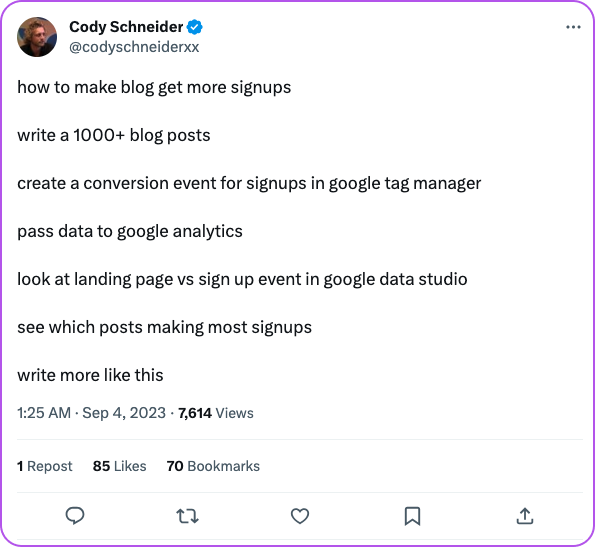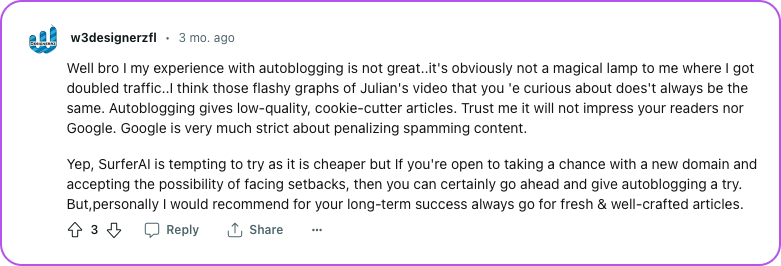AI Bulk Content Generation: Is it Ruining Your Website?

The Risks of Bulk Content Generation
What is bulk content generation? Imagine you need hundreds or thousands of articles for your website or blog. Instead of writing them all yourself, you could use AI to create content in bulk—an automated way to quickly produce a large amount of content. Sounds good, right? But think about this.
The quality of your content is very important for your online success. Good content attracts visitors, encourages sharing, and improves your ranking on search engines.
When you visit a site and find poorly written or irrelevant AI-made content, how does that affect your opinion of the brand? Usually not well! This shows why quality matters. It’s not just about filling space; it’s about giving value.
Many businesses make the mistake of using AI to generate lots of content without thinking about how it might hurt their website’s performance. While having a lot of content can help you get noticed by Google’s search algorithm, what if this AI content doesn’t meet Google’s quality standards? Your ranking could drop quickly.
Low-quality AI-generated bulk content can cause:
- Damage to your brand’s reputation
- Lower search engine rankings
- Your site being removed from search results entirely
- Less visitor engagement
- Higher bounce rates (visitors leaving after viewing only one page)
When thinking about AI-driven bulk content creation, remember that while it may seem like a quick fix to fill pages, it’s not always helpful in the long run. In fact, it can do more harm than good.
However, before ruling out AI for SEO bulk content completely, keep in mind that not all generated content is the same. With careful management and smart planning—like combining human editing with SEO writing tools such as Junia AI—bulk content generation can be part of a successful online strategy.
This article will explore the risks of large-scale AI content creation and how to handle these challenges to maintain an effective online presence.
Writesonic and Others: Real Help or Just Another Gimmick?


I've tried using AI tools like Writesonic and Copy AI to create many blog posts at once. These tools use GPT3 or GPT3.5 technology, but is this really a good way to build a successful blog? Let’s look at the main problems.
First, it’s unclear if AI-made bulk content can rank well on Google. From my experience, content made with GPT3 or GPT3.5 often fails plagiarism tests and clearly looks like it was written by AI because it lacks the human touch. Since Google keeps updating its system, mass-produced content like this might soon be penalized for trying to trick the search engine.
Also, these quickly made blogs often have duplicate content, which hurts SEO because:
Duplicate content confuses search engines, making it hard for them to pick the best version to show in search results. This can lower rankings for all versions.
Plus, creating many posts at once can be expensive. If it worked so well, wouldn’t these companies use it themselves?
You might wonder about platforms like writesonic, which focus on bulk content creation. Are they really delivering what they promise or just using smart marketing?
Based on some user reviews, opinions on Writesonic are mixed. The content it creates is similar to what you’d get from ChatGPT: clear but lacking originality and depth needed for professional blogging. These tools often focus more on quantity than quality, which hurts SEO since Google prefers unique and valuable content. Also, automated articles usually miss personal stories and unique views that connect with readers emotionally.
You may see YouTubers or Twitter users praising bulk-generated content. But keep in mind:
- They Push Mass Content Creation: Many promote AI article production as a game-changer but don’t mention the downsides.
- They Ignore Its Problems: While lots of articles sound good, these influencers often skip over how it can hurt credibility and SEO rankings.
Remember - not everything that shines is gold!
Be careful with advice that promotes mass AI-generated content. Focus on quality as much as quantity in your content plan.
The Downsides of Using AI for Mass Content Generation
AI has changed how we create large amounts of content quickly. But, like any tool, it has its problems. In this section, we'll look at the disadvantages of using AI to generate content in bulk.
Lack of Human Touch and Creativity in Mass-Produced AI Content
One big problem with using only AI to create content is that it doesn’t have the human touch and creativity. AI can produce a lot of content fast, but it often misses the originality, uniqueness, and personal relevance that only a human writer can add. This can result in bland content that doesn’t connect well with your audience.
Think about what makes your website special: it’s your authentic voice, personality, and creativity. If you rely just on AI-generated content, you risk losing that unique quality that makes your brand stand out. Your audience might find your site generic or impersonal without human input. To keep quality high in mass-produced AI content, the human touch is key to making it original, relevant, and interesting.
Quality and Accuracy Problems in AI-Generated Content
One problem with AI-generated content is that it can sometimes have quality and accuracy issues. Although AI has improved a lot recently, it still struggles to fully understand context, subtle meanings, and complex subjects. This can lead to mistakes, wrong facts, or poorly written sentences in the content. These problems can lower the overall quality and cause confusion or misunderstandings for readers.
Also, because AI creates content based on patterns and existing information, it might unintentionally include biased or incorrect details. This can harm your brand's reputation if the content is published without careful review. Checking the accuracy and quality of AI-generated content is important to keep your audience’s trust and maintain high standards in your content.
Not Enough Time to Manually Edit All AI-Generated Content
Using AI to create a lot of content can produce more articles than people can easily manage. This makes it hard for editors to review each one carefully. Important details like grammar, spelling, or how well the content flows might be missed, resulting in lower-quality work.
While AI helps save time in writing, it's important to keep the quality high by having humans check the content. Good ways to handle large amounts of content include setting up clear editing processes or mixing automation with selective human reviews to keep quality under control. Without proper editing, even the best AI-written content may not meet expectations.
Risk of Plagiarism and Duplicate Content with AI-Generated Articles
Plagiarism and duplicate content are big risks when using AI to create lots of content. Since AI learns from existing information, it can accidentally produce text that is very similar to what's already online. Content made by tools like GPT-3 or GPT-3.5 often fails plagiarism tests and can be recognized as AI-written. This means checking for plagiarism is very important before publishing AI content.
Search engines punish websites that have duplicate content, which can hurt your site's visibility and ranking. So, it's crucial to make sure any AI-generated content is original and unique before you publish it.
AI has made creating content faster and easier, but it also has drawbacks. It may lack human creativity, sometimes produce lower quality or inaccurate information, require a lot of manual editing, and risk plagiarism or duplicates. To keep your website's content authentic and high-quality, it's important to find a good balance between using AI and adding human input.
How Poor Content Hurts SEO and User Experience
In SEO, content is very important. But not all content is good. The quality, relevance, and originality of your content can greatly affect how well your website ranks in search results.

I want to share a personal story. I managed a blog that used lots of AI-generated content from a tool like writesonic. At first, our website traffic went up, which was exciting. But after a few months, our Google ranking dropped sharply because of SEO penalties.
We found out that our "unique" articles were just rewritten versions of other online content. Although they were grammatically correct and looked original at first, they didn’t offer real depth or unique value.
This taught me an important lesson — creating a lot of low-quality content without focusing on its value can actually hurt your SEO more than help it.
Search Engine Penalties from AI Bulk Content Generation
Search engines like Google want to show users the most relevant and useful results. If your site has a lot of low-quality, automatically generated content, it can cause problems. Google's systems are good at spotting bad content and don’t favor it.
What happens then? Your website might drop in search rankings or even be removed from search results entirely. Recovering from this can be tough.
Remember: Google’s algorithms reward websites with high-quality content and lower the ranking of those that offer a poor user experience.
Less Organic Traffic Because Content Isn’t Relevant
One problem with creating lots of content quickly is that it might not match what people are actually looking for. If your website’s content doesn’t fit users’ search needs, they won’t click on your site in search results, which hurts your ranking.
Even if visitors do come to your site, they won’t stay long if the content doesn’t help them. This mismatch lowers user engagement and causes more people to leave quickly. This brings us to the next issue – how user engagement and bounce rates are affected.
How User Engagement and Bounce Rates Can Be Affected
User engagement means how visitors interact with your website. Are they clicking on several pages? Are they spending enough time on each page?
Bounce rate is the percentage of visitors who leave your site after viewing just one page. A high bounce rate usually shows that visitors didn’t find what they wanted or weren’t happy with the content.
Imagine a visitor comes to your site from a search engine or link, expecting useful information. Instead, they see low-quality or irrelevant content. What happens? They leave quickly.
This tells search engines that your site isn’t helpful or relevant, which can lower your rankings. This creates a cycle that harms both your SEO and user experience.
What does this mean for you? Using AI to create lots of content quickly might seem easy, but it can do more harm than good. It’s better to focus on making quality content rather than just a large amount.
Keeping Your Brand's Voice and Tone
With so much content online, how does your brand get noticed? What makes you different? The answer is your brand voice and tone. These show your brand’s personality and values, guiding how you talk to your audience. But what happens when you add AI into the mix?
AI has changed many industries, including content creation. But it also brings challenges. One big issue is that AI struggles to copy a brand’s unique voice. While AI is impressive, it doesn’t have the human touch or subtle understanding that make a brand’s voice special.
Imagine you run an outdoor gear company with a relaxed, adventurous style. Now imagine AI creating formal, corporate-sounding blog posts for your site. That wouldn’t feel right, would it?
Keeping a consistent tone across all your website content is very important. Consistency leads to familiarity. Familiarity builds trust. And trust is key to loyal customers.
Think about your favorite brands. Whether they’re playful or serious, bold or classy, their voice usually stays the same everywhere. This consistency helps readers connect emotionally with the brand.
But using AI to create lots of content can cause changes in tone and style that break this consistency. Having one blog post sound like Shakespeare and another like a robot confuses readers and hurts your brand.
Remember, realness connects with people. Genuine content builds trust and credibility—something mass-produced content can’t do.
So how do we keep our unique brand voice while still using AI?
The goal isn’t to pick one over the other but to use both together (more on this next). The key is to let AI help create content while having humans review it to keep it consistent and authentic.
And always make sure your content—whether written by people or helped by machines—stays true to your brand voice and tone.
Ways to Avoid Problems When Creating Large Amounts of Content
Do you often feel stuck trying to make a lot of content while keeping it good? Don’t worry! Anyone can learn how to create great content. With the right plan, you can avoid common problems when making lots of content. Here are some helpful tips:
1. Combining AI with Human Editing and Proofreading
Using only AI to create content can cause issues like lack of creativity, mistakes, and even plagiarism. But what if we could use AI’s power while keeping the human touch? That’s where Junia AI helps!
Junia AI offers a smart solution by blending artificial intelligence with human editing and proofreading. This way, your content stays high-quality, original, and interesting.
Imagine this: You’re staring at a blank page, unsure how to start or express your ideas. Junia AI steps in, giving you a basic outline based on your keywords. Then, you can edit it however you want, adding your own thoughts and adjusting the tone to fit your brand.
The result? A great article that matches your brand and connects with your audience—all done faster than writing from scratch.
2. Using Content Curation and Repurposing
Content curation means collecting useful information about a topic from different places and organizing it clearly. This helps your readers by saving them time looking for the info themselves.
Not sure how to repurpose content well? Here are some ideas:
- Turn a blog post into an interesting infographic or use AI text-to-video tools to make a video.
- Pick out key points from long articles and turn them into social media posts.
- Change customer reviews into case studies.
- Turn webinars into podcasts or blog posts.
Repurposing helps you reach different parts of your audience who like different types of content – some prefer reading long articles, while others like watching short videos or listening to podcasts.
3. Taking Your Time to Create Content
"Slow and steady wins the race."
When making interesting and engaging content, rushing often leads to weak and shallow results. Instead, try the "slow churn" approach—focus on quality, not quantity. Here are some important steps for creating content slowly:
- Engagement is Important. By working at a slower pace, you can spend more time connecting with your followers. This means not just answering questions but starting and keeping meaningful conversations that build a community. Engagement is more than likes and shares; it’s about forming real connections and gaining loyal followers.
- Respecting Time. Your audience’s time matters—they don’t want to be overwhelmed with poor-quality content. Creating fewer, well-made pieces shows you value their attention and gives them useful information they can trust.
- Better SEO Results Over Time. Content made slowly usually has more detail and depth than quickly made posts. This helps your articles rank higher in search engines because they offer real value. Focusing on quality improves your SEO in the long run.
Remember: taking your time doesn’t mean being lazy—it means pacing yourself to make valuable content that truly connects with your audience and gives them helpful information.
To learn how many AI-generated blog posts to publish daily for the best engagement and SEO, check out this helpful guide.
Handling the challenges of creating lots of content isn’t about avoiding technology or sticking only to old ways. It’s about smartly combining tools like Junia AI with proven methods like human editing and reusing content.
Content creation isn’t just about producing a lot—it’s about sharing valuable information in an interesting way that connects with your audience. And yes—you can do this even when making content in bulk!
Finding Balance in Content Creation
Technology has changed how we create content. Thanks to AI, we can now produce large amounts of content quickly. But there's a catch. Like a coin with two sides, bulk content creation has both advantages and drawbacks.
Keep in mind that while AI can generate many articles fast, the quality may not always be great. That's why careful review is important! Don't you think quality matters more than quantity when making content?
Good content should be meaningful and useful to your readers. After all, that's what keeps them coming back. So, even though creating lots of content saves time and effort, it’s just as important to make sure it’s relevant and genuine.
"The key is to balance automation with human creativity."
Exactly! It’s not about relying only on AI or ignoring it completely. Think of AI as a tool that helps you work better. You can use AI to draft content quickly, then add your personal touch by editing and improving it.
Imagine an automated system handling boring tasks like keyword research or metadata creation, while you focus on being creative. Sounds great, right? With [Junia AI](https://www.junia.ai/blog/write-more-content-in-less-time), this is possible!
Remember when we talked about reusing old content? That’s another smart way to keep quality high while producing more content faster. Updating old posts with new info or presenting them differently gives them new life.
So, keep in mind—bulk content creation has its benefits, but finding the right balance is important. Focus on quality over quantity—your readers and search engines will appreciate it!